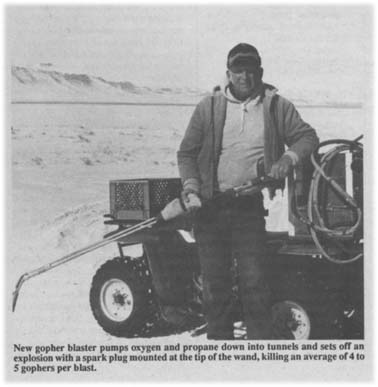
It's hard to believe but professional gopher trapper Jerry Stager and his wife caught more than 65,000 gophers last year, including 25,000 on one farm alone.
Stager's reputation as a gopher killer has grown rapidly in the four years he's been trapping as word of his success spreads. In fact, he now charges for a 1 1/2-day lesson in professional gopher trapping and he says anyone who learns his system can pay back the cost of the lesson in just a few days.
"One man can catch as many as 100 to 200 gophers a day. We charge farmers and ranchers per gopher, depending on how far we have to travel from home. That's a bargain for the farmer because gophers can ruin a farm. It's estimated that one gopher in a hayfield costs the value of two bales per year, not to mention the damage done to equipment. Some gopher-infested fields are almost unbelievable. I've seen gopher mounds as big as tables and so close together you can walk over a quarter section of land and make every step on a gopher mound," says Stager, who lives in Orovada, Nev., but will travel anywhere to trap.
Stager has been trapping gophers full-time during spring, fall and summer months for the past four years. In the wintertime he traps coyotes and bobcats. When he started trapping gophers, he knew he had to devise fast, efficient methods to make it pay.
"It takes the average farmer about 15 min. to set a gopher trap. With our system, you can find the tunnel, set a trap, flag it, and drive away in 35 sec. or less. One man can set 30 to 50 traps per hour, and each trap can be set as many as three times in a day. Most gophers are caught within 2 hrs. so I set 100 to 200 traps and then go bank and 'milk' the line, checking and resetting traps set earlier in the day," says Stager, whose wife Melba works with him full time along with several part time employees who have been trained in his methods.
The trappers work fields on 4-wheel ATV's that have cargo baskets on front and back to carry traps, flags, a shovel and dead gophers. Here's how Stager operates in a gopher-infested field:
He drives up to a mound and hops off the ATV, grabbing the shovel carried in a pvc pipe carrier across the back of the rig. In a standing position, he holds the shovel upside down and uses the handle end of it -- which is sharpened to a point -- to quickly probe the mound for the tunnel. As soon as he detects it, he flips the shovel over and scoops away the dirt at the top of the tunnel the way you'd scoop pudding with a spoon. Then he lays the shovel down, cocks one of his modified cinch-type traps, and shoves it into the tunnel. Lastly, he sticks one of his 3-ft. long metal (he uses 5/32-in. dia. welding rod) flags through a hole in the end of the trap and gets back on the ATV to the next trap. The flags have steel washers welded to the top to which are fastened strips of white bed sheet and lengths of red tape.
Stager says that because of his methods and the way he modifies his traps, he catches gophers in more than 75% of the traps he sets. "It's impossible to get all the gophers in one field but if we can trap a field about 4 times in one season, we can generally clean out 80 to 90% of them, getting the populations down to a level where the farmer can handle the problem. Last year we took 25,000 gophers off one large farm but they've still got a problem. That's because two gophers can produce more than 2,000 offspring in two years. When you trap one adult gopher, there's usually a litter of little ones still underground."
Stager uses a cinch-type trap that squeezes the animal to death with two jaws. Stager sharpens the points on the jaws so that the traps will stick gophers when they don't catch the entire body. He also drills a hole in one end of each trap so he can stake them down with his flags.
Stager has made and studied video tapes of gophers getting caught in his traps so that he knows how they react when they first spot a trap. He's used that knowledge to place traps in the best possible positions.
Stager has had a lot of interest in his lessons. "One fellow spent a day and a half with us and then went out and spent the money for equipment. He earned all of his initial investment back in 10 days and from then on everything he made was profit."
Gopher trapping isn't for everyone, though, notes Stager. "It's hard work and you have to work at it full time to make it pay. But there's a big demand out there for the service. Many farms have fields that have almost been ruined because of gopher damage." Stager will travel almost anywhere to trap and he is also considering making an instructional video available for farmers in other parts of the country.
